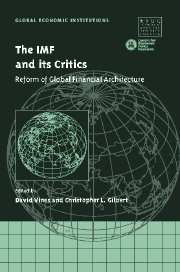Book contents
- Frontmatter
- Contents
- List of figures
- List of tables
- List of contributors
- Acknowledgements
- Introduction
- 1 The IMF and international financial architecture: solvency and liquidity
- 2 Progress towards greater international financial stability
- 3 International coordination of macroeconomic policies: still alive in the new millennium?
- 4 The Report of the International Financial Institution Advisory Commission: comments on the critics
- 5 Reforming the global financial architecture: just tinkering around the edges?
- 6 The IMF and capital account liberalisation
- 7 How should the IMF view capital controls?
- 8 The resolution of international financial crises: an alternative framework
- 9 Whose programme is it? Policy ownership and conditional lending
- 10 The IMF and East Asia: a changing regional financial architecture
- 11 The role of the IMF in developing countries
- 12 Argentina and the Fund: anatomy of a policy failure
- 13 Countries in payments' difficulties: what can the IMF do?
- 14 Accountability, governance and the reform of the IMF
- 15 The IMF at the start of the twenty-first century: what has been learned? On which values can we establish a humanised globalisation?
- Index
- References
8 - The resolution of international financial crises: an alternative framework
Published online by Cambridge University Press: 04 December 2009
- Frontmatter
- Contents
- List of figures
- List of tables
- List of contributors
- Acknowledgements
- Introduction
- 1 The IMF and international financial architecture: solvency and liquidity
- 2 Progress towards greater international financial stability
- 3 International coordination of macroeconomic policies: still alive in the new millennium?
- 4 The Report of the International Financial Institution Advisory Commission: comments on the critics
- 5 Reforming the global financial architecture: just tinkering around the edges?
- 6 The IMF and capital account liberalisation
- 7 How should the IMF view capital controls?
- 8 The resolution of international financial crises: an alternative framework
- 9 Whose programme is it? Policy ownership and conditional lending
- 10 The IMF and East Asia: a changing regional financial architecture
- 11 The role of the IMF in developing countries
- 12 Argentina and the Fund: anatomy of a policy failure
- 13 Countries in payments' difficulties: what can the IMF do?
- 14 Accountability, governance and the reform of the IMF
- 15 The IMF at the start of the twenty-first century: what has been learned? On which values can we establish a humanised globalisation?
- Index
- References
Summary
Introduction
Since the mid-1990s, the incidence of financial crises among emerging-market countries appears to have increased (Hoggarth and Saporta, 2001). In response, governments and international financial institutions have worked intensively on ways to reduce the likelihood and virulence of crises. This is the debate on the so-called ‘international financial architecture’ (see, for example, Eichengreen, 2002, for an overview).
There is now a fairly widespread consensus within the official community on appropriate crisis-prevention measures (King, 1999; Eichengreen, 2002). For example, the best defence against financial crises is to establish sound macroeconomic fundamentals and to have a credible policy framework in place to deal with economic and financial shocks. A broad international consensus has also emerged on the importance of prudent balance sheet management, with a particular focus on the balance sheet positions of governments and the financial system. Considerable work has also been done by international groups to establish codes and standards of best public policy practice. The official community should not be prescriptive about the adoption of standards. But it should promote transparency about the degree of country compliance with them (see Drage and Mann, 1999).
Even with such prevention measures in place, however, crises will still occur from time to time. Moreover, there is less consensus among policy-makers on appropriate crisis-resolution measures in these circumstances. This fact is well recognised by, among others, the IMF (Krueger, 2001). The IMF has responded to crises by providing often large-scale lending packages, conditional on the implementation of macroeconomic and structural reform.
- Type
- Chapter
- Information
- The IMF and its CriticsReform of Global Financial Architecture, pp. 207 - 224Publisher: Cambridge University PressPrint publication year: 2004
References
- 1
- Cited by



